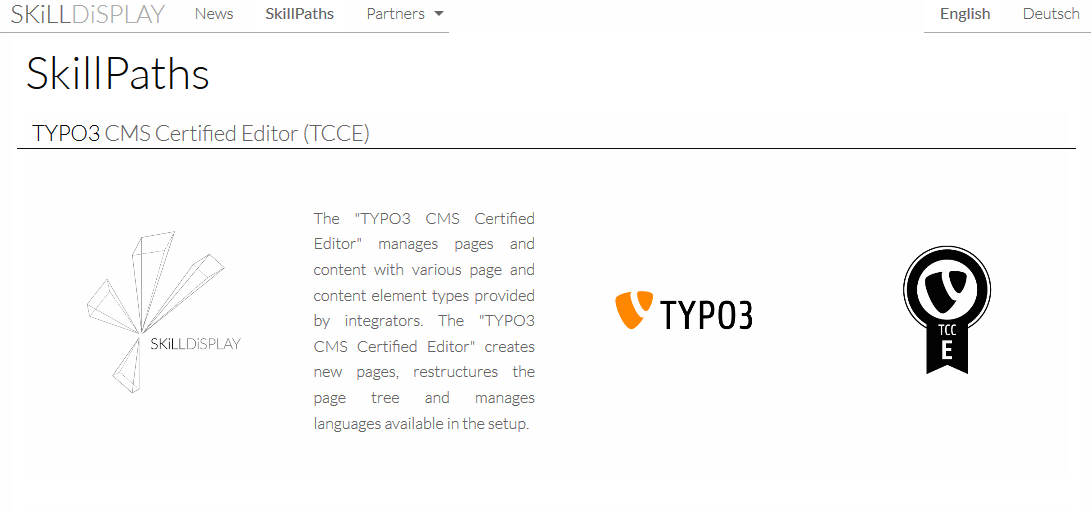
SkillDisplay - Who Uses TYPO3? The Way of Finding Your Target Group
Thanks to Christina from SkillDisplay for sharing!
A big thank you goes to the great TYPO3 community who answered some questions and helped us in creating realistic personas! With the newly gained information we want to improve the SkillDisplay platform. At the end of this post you can see our persona results.
This blogpost is all about:
Who or what is a persona?
How to create personas
Best practice: TYPO3 personas – Editor, Integrator, Developer, Consultant
Who or what is a persona?
Put it in a nutshell: personas are fictive characters used to describe and get to know your target group. Knowing what your personas need and why they need it helps in creating better content, services and products. If you can’t answer these questions, you might think of making something different.
Not everyone likes personas. They are just another tool, which you can use in a positive or negative way. It depends on the team whether or not you like them and if they are useful to you.
How to create personas
Here is a step-by-step guide on how to create personas.
1. What do you want?
What should your persona look like, which data is necessary for you? Here are some examples:
Basics: name, gender, age, country, language, profile photo
Education: education level, schools, university, courses, skills
Career: previous jobs, place of employment, job roles, industry
Goals: question/problem to be solved, goal in life, goal at job
Others: social media, learning resources, blogs they read/write, hobbies
2. Get your content
There are several ways to research and get information. Here are some suggestions
Use data gained from analytic tools
When you know what kind of data you are searching for, website and social media analytics are perfect to get the basics. Where is your audience from? What language do they speak?Ask your audience to fill in a form
Here you can ask people about their hobbies, their work and education. Specific questions that relate to your topic can also be asked here.Know your users
It’s also good to analyse users you know personally. Is there anyone of the team who has direct contact to the customers?Brainstorming
For information you do not have, be creative and try to put yourself in the personas place. Think of special needs or problems your personas could have. You can also ask your team for help.
3. Write about your personas
Now that you have all the information about your personas, it’s time to create them. Find a format that suits you best. From a short text to a multiple page curriculum vitae - everything is possible.
Define a place where you save the personas so they don’t get lost!
4. Use the personas
When you need to make decisions in any way or create something new, use your personas.
Find your target audience
Increase usability
Create website content
Plan new products / services
Publish posts on social media channels
Best practices: TYPO3 personas
We focused on TYPO3 users, because our target “learner” group at the moment are people who want to expand their knowledge in the CMS sector. We have already created a SkillPath for TYPO3 CMS Certified Editor (TCCE), one for TYPO3 Fluid Basics, which is part of the TYPO3 CMS Certified Integrator (TCCI) and we’re working on some additional paths. You can find them on the SkillDisplay platform at the register “SkillPaths”.

And here they are - our (shortened) personas and the associated TYPO3 certifications. We’ve also created specific questions we want to consider to improve the platform even further.
TYPO3 CMS Certified Editor (TCCE)
Editors create and utilise sites and content. They structure the page tree and manage languages on the website.

As we already have an Editor-SkillPath, we‘re keeping an extra eye on this group.
Sophie (25) is completely new to TYPO3. When she first started studying media technology, she read about content management systems, which she found very interesting. She is a bit scared of the whole new thing and doesn’t know if she can learn this on her own. In her free time she dances a lot.
“How can we support the process and help her feel more confident?”
Our second persona is a student aged 17, who is a TYPO3 newbie and is learning it at school. His name is Noah and he’s very interested in web development. As he’s very motivated and sets himself high standards in everything that he does, he creates and designs both web and print content in his free time. He wants to do the Editor Certification and needs to practice a lot.
“How can we help him prepare for the certificate?”
Alina (23) already is a TYPO3 CMS Certified Editor (TCCE) and is at a university for IT. The next step would be becoming an integrator, but she lacks motivation and can’t find enough time either. She has a lot of “non-computer” hobbies and does a lot of sport.
“How can we motivate her to take the next step?”
Simon (21) is a very lazy and chaotic person, who also did the TYPO3 CMS Certified Editor (TCCE). It’s been quite some time since he’s last used TYPO3. He studies engineering, but is still interested in web development. He needs to set goals and refresh his knowledge.
“How can we help him stay focused and structured?”
TYPO3 CMS Certified Integrator (TCCI)
Integrators develop the template for websites. They configure extensions and are responsible for access rights.
Neele (42) is a web developer, where she has the role of the integrator. She did both the editor and the integrator certification. She works hard to be successful and uses TYPO3 in her daily work for both small and complex websites. She is proud to be a part of the TYPO3 community. When she doesn’t develop websites, she loves playing piano.
“How can we give her recognition?”
TYPO3 CMS Certified Developer (TCCD)
Developers have a lot experience and work according to state-of-the-art technologies. They write clean code and know the architecture, design patterns, best practices and internals.
Nick (36) is a web developer but never did any certificates. The company he works for doesn’t require it and he himself doesn’t feel the need to validate his know-how with a piece of paper. He likes TYPO3 because “it’s cool” and because of the "inspire people to share" idea. Nick uses TYPO3 for all websites and web applications and sticks to the TYPO3 Coding Guidelines. He learns by reading a lot of source code and blog posts and he’s also taken part in quite a few workshops.
“How can we provide high quality learning content?”
The second developer persona, we’ll call her Theresa, aged 29. She is a kinaesthetic learner, so she likes learning by doing. She uses projects and tries new things to reach her goals. Documentation is an essential learning resource for her. In her free time she does a lot of sports and likes photography.
“How can we give her learning type specific content?”
TYPO3 CMS Certified Consultant (TCCC)
Consultants are professionals who provide advice to customers with regards to their TYPO3 projects: consultants, project managers and product owners.
Tobias (37) is a consultant, he is a Scrum Master and he likes to learn new things. TYPO3 is his business and it is great fun. He’s done two certificates, TYPO3 CMS Certified Editor and TYPO3 CMS Certified Consultant. He learns TYPO3 with literature and in his daily work. Fitness and computer games are activities he does in his free time.
“How can we show him what he doesn’t know already?”
So there are so many individuals who are learning TYPO3, why don’t you also show what you can do? All of them began with the basics. Editor, Integrator, Developer or Consultant? They all start with the very same first step “What is a CMS?”, and you can do that, too! Register on the SkillDisplay platform and start learning something new.